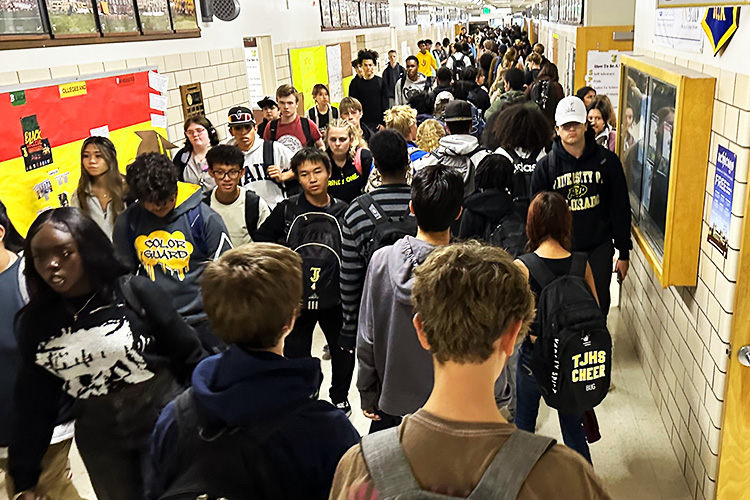
The freshmen class is a large contributor to the overflowing TJ hallways. photo by Ravi Apte
The TJ community continues to grow with an influx of freshmen.
Over the past couple of years, the incoming freshmen classes at TJ have grown substantially. Currently, the school’s population sits at over 1300 students, with total enrollment at an all time high. The presence of so many students is evident in the packed hallways and crowded classrooms.
Despite TJ’s rising admissions, Denver Public Schools is experiencing low enrollment numbers across the district. According to the strategic regional analysis report provided by DPS, student enrollment has decreased by nearly 5% over the past four years. This trend is expected to continue. With gentrification and high costs of living in Denver, families are leaving DPS and moving to the surrounding districts. As for enrollment at TJ, however, numbers have continued to increase.
In Principal Mike Christoff’s first year, there were only about 900 students enrolled in the entirety of TJ. “We have seen growth of 30-60 kids each year,” Christoff noted. “Enrollment was at a steady 1,050 for about five years.” Now, during the 23-24 school year, TJ sits at about 1,365 students. When asked why the freshmen class specifically has been so large, Christoff explained that it’s largely due to families coming back to the district, as well as the school’s reputation. “It’s super diverse and has a good culture, which is really attractive to families.”
While these aspects are bringing in an immense amount of freshmen, they are also the reason why the junior and senior classes have kept such high enrollments. This year’s senior class is made up of around 280 students. More students are choosing to stay at TJ for all four years, keeping school enrollment numbers high.
With the growth of the student body, class sizes are also getting larger. Freshmen classes are usually kept small, but with so many students it has become difficult to continue that trend. The number of class sections offered for freshmen are built each year based on the projections. Administration then decides how many sections to offer, and once August comes around they are able to condense or add to them.
Social Studies teacher Dakota Trammell teaches around 120 freshmen each day. Throughout her five years at TJ, she has seen her smallest class increase from 26 to 32 students. More students brings the concern of less one-on-one learning-time. “Many students nowadays have IEP’s or 504’s,” said Trammell, expressing her worries that she is simply not able to do enough for her students. “One teacher can not always provide all those supports. With that, equity comes into play.” Providing individualized learning has become more difficult for Trammell with her large classes. To accommodate for all needs, she tries to provide “chunking” in lessons. These practices allow students to gain a better understanding of the content and acquire it in more engaging ways, rather than solely through a lecture.
While the presence of so many students can be both positive and negative, the TJ community seems to be more united than ever. The freshmen are finding their way around, and teachers are trying to accommodate students in any possible way. The school will continue to grow and the community and culture will likely grow with it.